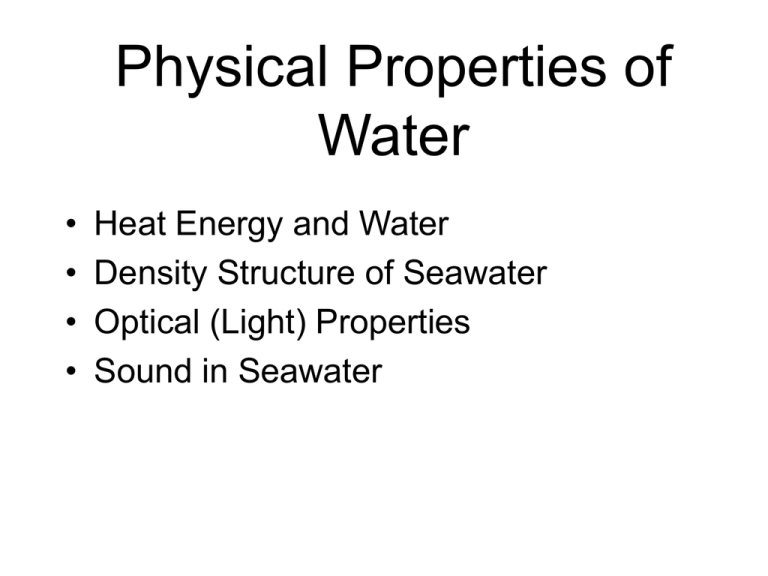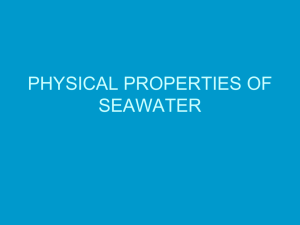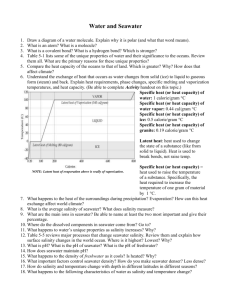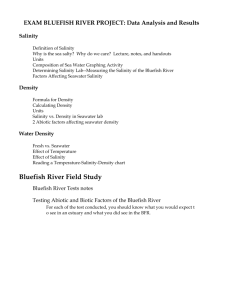Physical Properties of Water
advertisement

Physical Properties of Water • • • • Heat Energy and Water Density Structure of Seawater Optical (Light) Properties Sound in Seawater Density & Temperature Taking heat energy away → Heat energy causes water molecules to vibrate greatly and space themselves out; also few H-bonds that break and reform very rapidly. Maximum density at 4ºC when water molecules vibrate less and pack together the tightest. Density decreases at < 4ºC as more and more H-bonds form. The dramatic drop in density occurs when the perfect crystal forms; complete H-bonding; ice. This requires removal of a lot of heat without a temperature change. ICE FLOATS! Perfect water crystal Heat Energy and Water • Heat is energy produced by molecular vibration (number of molecules and how rapidly they vibrate). The calorie is the unit of heat. • Temperature is only a measure of how rapidly molecules vibrate. • Different substances have different temperature responses for the same amount of heat added or removed. • Specific heat is the measure of how much heat is required to raise 1g of a substance by 1ºC. • Specific heat of liquid water is 1.0 calories. Relative to other substances, water can absorb or release a lot of heat with little temperature change. • In contrast, the specific heat of sand is about 0.1 calories. It does not resist change in temperature with gain or release of heat. Think of hot, mid-day, beach sand versus the cooler seawater; both received the same solar energy. Sensible versus Latent Heat of Water Liquid water temperature responds in a constant manner as heat is added or removed; we call this sensible heat as we can make sense of heat change by measuring temperature change with a thermometer. However, no temperature change is seen upon removing the 80cal/g from liquid water at 0ºC to get ice at 0ºC. This is called the latent heat of fusion (freezing). There is also a latent heat of evaporation of 585 cal/g to get water to go to gas, i.e. energy needed to break all H-bonds. What about Seawater? • Physical properties discussed above are for pure water, i.e no salts. • Salinity will decrease freezing point (-1.9.ºC for 35 ppt). Salts interfere with formation of perfect water crystals. Only freshwater freezes and the salts are excluded from the ice as dense brine solutions. • Salinity slows evaporation, as ions of salts attract water tighter than H-bonds of other water molecules. • Salinity increases the density of water. Density Structure of Seawater • Both temperature and salinity influence the density of seawater. • Ocean waters will structure themselves in layers of increasing density with depth, called strata. • Two different water parcels can have very different temperatures and salinity yet have the same density. • Consider the T-S diagram below. Temperature is the dominant factor in controlling density in the ocean, particularly when salinity does not vary dramatically. Surface water (<200 m) absorbs the majority of solar radiation and converts it to heat, slowly raising surface water temperature. A distinct layer of warmer lower density seawater forms at the surface zone when there is ample sunlight and calm conditions. The transition depths between warm surface zone and cold denser deep water is called the thermocline (thermo = heat; cline = change). Thermocline characteristics vary with latitude due to differences in solar radiation inputs with latitude. Weak to no thermocline is seen at the poles due to cold surface water being mixed by sinking and mixing by storms. When a thermocline does exists, we refer to the water as being stratified (layered). Seawater can also be stratified due to density differences related to salinity. The depth of rapid salinity change is called a halocline (halo = salt). The combination of temperature and salinity determines overall density; the depth of rapid density change is called a pycnocline (pycno = density). Largely due to the temperature influence on density, pycnoclines are greatest (deepest) at the equator, and shallow to non-existent above 60º North of South latitude. Winds generate waves to keep the thin surface zone mixed to the top of the thermocline. Deep water is a massive volume (80%) and very cold (2-5ºC) Optical Properties of Water • Refraction of light. When light penetrates a medium of different density and at an angle other than 90º it will bend. • Refraction applies to sound as well, as both light and sounds are waves. • Refraction of light can create optical distortions and influence the depth that light will travel before absorbed. • The marching soldiers example: Refraction: • A fish in water looks bigger and closer than it really is due to bending of light toward the surface as it leaves the water to your eye. PSYCH! Light is absorbed and scattered as it passes through water, so less light reaches greater depths. Different wavelengths of light absorb differently in pure water. Blues and greens penetrate deepest and reds the least. Why the “deep blue sea”? Particles and colored dissolved organic matter and further influence how quickly different colors of light are absorbed in natural waters. Light greatly influences life! Sound and Seawater Sound is an energy wave produced by rapid pressure change. Like light it is lost over distance in seawater due to spreading, scatter, and absorption, but sound can travel much farther than any light in seawater, particularly low frequency sound waves. Some marine mammals use sound to “see”, a process called echolocation, much like Sound Navigation and Ranging (SONAR) technology used by submarines and ships. Average speed of sound in seawater is 5-times faster than in air (1,500 m/s). Increases in temperature or pressure will increase sound speed in seawater. Sound traveling through water of different temperature or pressure will bend; refraction. A depth of minimum sound velocity results from these properties. Sound Fixing and Ranging (SOFAR) Channel Best depth for listening to others!







